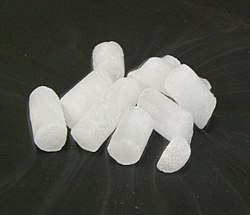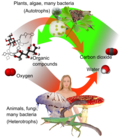Carbon dioxide

Carbon dioxide (CO2) is a chemical compound and is acidic. It is a gas at room temperature. It is made of one carbon and two oxygen atoms. People and most animals release carbon dioxide when they breathe out. Also, every time something organic is burnt (or a fire is made), it makes carbon dioxide. Plants use carbon dioxide to make food. This process is called photosynthesis.[1] The properties of carbon dioxide were studied by the Scottish scientist Joseph Black in the 1750s.
Carbon dioxide is a greenhouse gas.[2] Greenhouse gases trap heat energy. Greenhouse gases change the climate and weather on our planet, Earth. This is called climate change. Greenhouse gases are a cause of global warming, the rise of Earth surface temperature.
Its concentration in Earth's atmosphere since late in the Precambrian was regulated by photosynthetic organisms and geological phenomena (mainly volcanos).
Biological role
Carbon dioxide is an end product in organisms that obtain energy from breaking down sugars, fats and amino acids with oxygen as part of their metabolism. This is a process known as cellular respiration. This includes most animals, many fungi and some bacteria. In higher animals, the carbon dioxide travels in the blood from the body's tissues to the lungs where it is breathed out. Plants take in carbon dioxide from the atmosphere to use in photosynthesis.
Dry ice
Dry ice, or solid carbon dioxide, is the solid state of CO2 gas below -109.3 °F (-78.5°C). Dry ice does not occur naturally on earth but is man made. It is colorless. People use dry ice to make things cold, and to make drinks fizzy, kill gophers, and freeze warts. The vapor of dry ice causes suffocation and eventually, death. Caution and professional assistance are recommended whenever dry ice is in use.
At usual pressure it will not melt from a solid to a liquid but instead changes directly from a solid to a gas. This is called sublimation. It will change directly from a solid to a gas at any temperature higher than extremely cold temperatures. Dry ice sublimates at normal air temperature. Dry ice exposed to normal air gives off carbon dioxide gas that has no color. Carbon dioxide can be liquified at pressure above 5.1 atmospheres.
Carbon dioxide gas that comes off of dry ice is so cold that when it mixes with air it cools the water vapor in the air to fog, which looks like a thick white smoke. It is often used in the theater to create the appearance of fog or smoke.
Isolation and production
Chemists can get carbon dioxide from cooling air. They call this air distillation. This method is inefficient because a large amount of air must be refrigerated to extract a small amount of CO2. Chemists can also use several different chemical reactions to separate carbon dioxide. Carbon dioxide is made in the reactions between most acids and most metal carbonates. For example, the reaction between hydrochloric acid and calcium carbonate (limestone or chalk) makes carbon dioxide:
- [math]\displaystyle{ \mathrm{2 \ HCl + CaCO_3 \longrightarrow CaCl_2 + H_2CO_3} }[/math]
The carbonic acid (H2CO3) then decomposes to water and CO2. Such reactions cause foaming or bubbling, or both. In industry, such reactions are used many times to neutralize waste acid streams.
Quicklime (CaO), a chemical that has widespread use, can be made heating limestone to about 850 °C. This reaction also makes CO2:
- [math]\displaystyle{ \mathrm{CaCO_3 \longrightarrow CaO + CO_2} }[/math]
Carbon dioxide is also made in the combustion of all carbon-containing fuels, such as methane (natural gas), petroleum distillates (gasoline, diesel, kerosene, propane), coal or wood. In most cases, water is also released. As an example, the chemical reaction between methane and oxygen is:
- [math]\displaystyle{ \mathrm{CH_4 + 2 \ O_2 \longrightarrow CO_2 + 2 \ H_2O} }[/math]
Carbon dioxide is made in steel mills. Iron is reduced from its oxides with coke in a blast furnace, producing pig iron and carbon dioxide:[3]
- [math]\displaystyle{ \mathrm{Fe_2O_3 + 3 \ CO \longrightarrow 2 \ Fe + 3 \ CO_2} }[/math]
Yeast metabolizes sugar to produce carbon dioxide and ethanol, also known as alcohol, in the production of wines, beers and other spirits, but also in the production of bioethanol:
- [math]\displaystyle{ \mathrm{C_6H_{12} O_6 \longrightarrow 2 \ CO_2 + 2 \ C_2H_5OH} }[/math]
All aerobic organisms produce CO2 when they oxidize carbohydrates, fatty acids, and proteins in the mitochondria of cells. The large number of reactions involved are exceedingly complex and not described easily. (They include cellular respiration, anaerobic respiration and photosynthesis). Photoautotrophs (i.e. plants, cyanobacteria) use another reaction: Plants absorb CO2 from the air, and, together with water, react it to form carbohydrates:
- [math]\displaystyle{ \mathrm{nCO_2 + nH_2O \longrightarrow (CH_2O)n + nO_2} }[/math]
Carbon dioxide is soluble in water, in which it spontaneously interconverts between CO2 and H2CO3 (carbonic acid). The relative concentrations of CO2, H2CO3, and the deprotonated forms HCO−
3 (bicarbonate) and CO2−
3(carbonate) depend on the acidity (pH). In neutral or slightly alkaline water (pH > 6.5), the bicarbonate form predominates (>50%) becoming the most prevalent (>95%) at the pH of seawater, while in very alkaline water (pH > 10.4) the predominant (>50%) form is carbonate. The bicarbonate and carbonate forms are very soluble. So, air-equilibrated ocean water (mildly alkaline with typical pH = 8.2–8.5) contains about 120 mg of bicarbonate per litre.
Industrial production
Industrial carbon dioxide is produced mainly from six processes:[4]
- By capturing natural carbon dioxide springs where it is produced by the action of acidified water on limestone or dolomite.
- As a by-product of hydrogen production plants, where methane is converted to CO2;
- From combustion of fossil fuels or wood;
- As a by-product of fermentation of sugar in the brewing of beer, whisky and other alcoholic beverages;
- From thermal decomposition of limestone, CaCO3, in the making of lime (Calcium oxide, CaO);
Chemical reaction
Carbon dioxide can be created with a simple chemical reaction:
Carbon Dioxide Media
Stretching and bending oscillations of the CO2 molecule. Upper left: symmetric stretching. Upper right: antisymmetric stretching. Lower line: degenerate pair of bending modes.
Pressure–temperature phase diagram of carbon dioxide. Note that it is a log-lin chart.
Overview of the Calvin cycle and carbon fixation
Overview of photosynthesis and respiration. Carbon dioxide (at right), together with water, form oxygen and organic compounds (at left) by photosynthesis (green), which can be respired (red) to water and CO2.
Symptoms of carbon dioxide toxicity, by increasing volume percent in air
Rising levels of CO2 threatened the Apollo 13 astronauts, who had to adapt cartridges from the command module to supply the carbon dioxide scrubber in the Apollo Lunar Module, which they used as a lifeboat.
A carbon dioxide sensor that measures CO2 concentration using a nondispersive infrared sensor
References
| Wikimedia Commons has media related to Lua error in Module:Commons_link at line 62: attempt to index field 'wikibase' (a nil value).. |
- ↑ Fullick, Ann (2011). Edexcel IGCSE Biology Revision Guide. Pearson Education. p. 40. ISBN 9780435046767.
- ↑ Woolley, Steve (2011). Edexcel IGCSE Physics Revision Guide. Pearson Education. p. 59. ISBN 9780435046736.
- ↑ Strassburger, Julius H. (1969). Blast Furnace: Theory and Practice. New York: American Institute of Mining, Metallurgical, and Petroleum Engineers. ISBN 9780677104201.
- ↑ Pierantozzi, Ronald (2001). "Carbon Dioxide". Kirk-Othmer Encyclopedia of Chemical Technology. John Wiley & Sons, Inc. doi:10.1002/0471238961.0301180216090518.a01.pub2. ISBN 0471238961.










